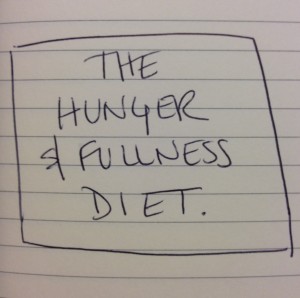 This blog posts references “intuitive eating” — which can be loosely described as making decisions around food based on what our bodies want to eat, rather than what our minds think it should. If you’re totally unfamiliar with “intuitive eating,” here’s a basic primer on core principles. While intuitive eating in and of itself is not “the answer” to your food problem, the basics are helpful to know if you’re struggling to get off traditional dieting.
This blog posts references “intuitive eating” — which can be loosely described as making decisions around food based on what our bodies want to eat, rather than what our minds think it should. If you’re totally unfamiliar with “intuitive eating,” here’s a basic primer on core principles. While intuitive eating in and of itself is not “the answer” to your food problem, the basics are helpful to know if you’re struggling to get off traditional dieting.
Now on to today’s topic…
The “hunger-and-fullness diet” is my cheeky way of describing the perversion of intuitive eating that women fall prey to when they attempt intuitive eating with a diet mentality—
e.g. “I must only eat when I’m hungry and stop when I’m full…or else.”
Like with any other diet, if you’re following hard and fast rules — that is, if you’re “on a wagon” with food — it’s only a matter of time before you’re gonna get knocked off…even if that wagon is based on the “guidelines” of intuitive eating.
(Did my quotation marks effectively demonstrate my disdain for the term “guidelines?” The word “guideline” implies the word “should” by definition. No dif.)
What if,
instead of turning our hunger signals into boundaries by which to judge our performance with food, we simply saw our hunger signals for what they actually are: information.
From a biological standpoint, that’s all a hunger signal is—
INFORMATION.
When I feel a growl in my stomach, that’s simply information that my blood sugar is dropping.
When I get a yeast infection after eating too much sugar the week before, that’s just information about how my body is reacting to that sugar.
When my stomach is distended with food, that’s simply information telling me how much space is comfortably left inside.
When I eat a peanut and my face swells up like a balloon, that’s information about my probable peanut-allergy.
As a human being with free will and reign over my own body,
I get to do with that information what I damn well want to.
I might choose to stop when I’m full because I legitimately don’t want to feel stuffed before I go back to work…
or I might choose to keep eating the raw chocolate mousse because…yolo…it’s Sunday…I have nowhere else to be…and that mousse is f*cking worth it.
Just like feelings of fatigue are information that my body is low on sleep,
and I can choose to go to bed early so my body feels better in the morning,
OR I can stay up because my best friend is visiting from out of town and we need to finish our Friends marathon.
I am empowered to make my own choices, when all the information is in.





